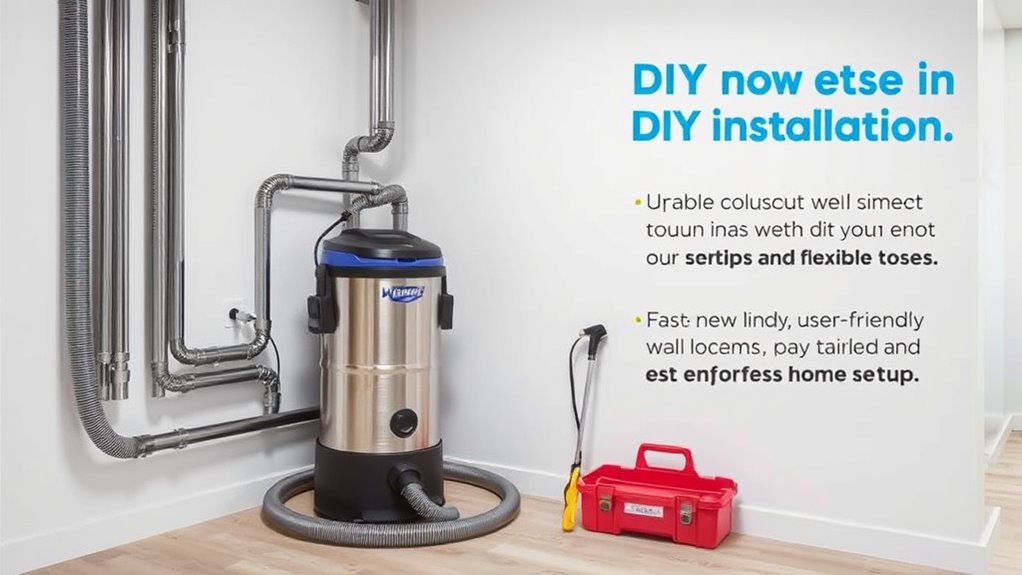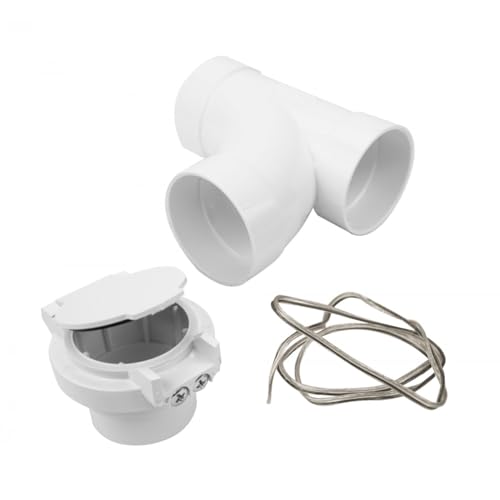If you’re looking for the best DIY central vacuum kits, I recommend options like the OVO Central Vacuum Installation Kit, universal low-voltage systems, and electric kits with various pipe lengths. Many include fittings, inlets, and accessories to make installation straightforward. I’ve found these kits are compatible with popular brands and come with the necessary components for easy setup. Keep exploring to discover detailed insights and find the perfect solution for your home.
Key Takeaways
- Complete kits include pipes, fittings, wiring, and manuals for easy DIY installation across various home sizes.
- Compatibility with multiple brands like Nutone, Eureka, and Electrolux ensures broad system integration.
- Features durable PVC piping, fittings, and optional accessories to customize and optimize system performance.
- Designed for straightforward assembly with labeled parts, step-by-step instructions, and minimal tools required.
- Consider system layout, pipe length, and wiring compatibility to ensure optimal airflow and reliable operation.
OVO Central Vacuum Installation Kit with PVC Pipe and Fittings
If you’re looking for a versatile and easy-to-install central vacuum kit, the OVO Central Vacuum Installation Kit with PVC Pipe and Fittings is an excellent choice. It’s compatible with all systems using 2-inch pipes and low-voltage wiring. The kit includes 48 feet of PVC pipe, three round door inlets with brackets, and various elbows and couplings for flexible routing. It also provides 50 feet of low-voltage wiring and PVC solvent cement for secure connections. Designed in white, it’s straightforward to assemble, making your DIY installation smooth and hassle-free. This kit is perfect for upgrading or installing a central vacuum system yourself.
Best For: DIY homeowners and contractors seeking a versatile, easy-to-install central vacuum system upgrade or installation with comprehensive pipe and fittings.
Pros:
- Compatible with all 2-inch pipe central vacuum systems using low-voltage wiring
- Includes a complete set of fittings, elbows, and wiring for flexible routing and installation
- Easy to assemble with PVC solvent cement and straightforward instructions
Cons:
- Limited to systems that use 2-inch pipes and low-voltage wiring, not suitable for larger or different configurations
- May require additional tools or fittings for complex routing or specific wall setups
- PVC components may need careful handling to avoid damage during installation
Universal Low Voltage Installation Kit (3), 80 ft. of Pipe
The Universal Low Voltage Installation Kit (3) with 80 feet of pipe stands out as an ideal choice for DIY enthusiasts seeking a complete, ready-to-install central vacuum system. It includes everything needed for setup, such as pipe sections, fittings, couplings, brackets, wire, and an installation manual. Compatible with most central vacuum brands using Low Voltage Hayden 1500 Style inlets, it offers flexibility with different inlet quantities. The kit’s 80 feet of pipe and wire, along with included accessories, make installation straightforward. Plus, the glue and cable ties ensure a tidy, secure setup. It’s an all-in-one solution perfect for confident DIYers aiming for a professional result.
Best For: DIY homeowners and installation professionals seeking a comprehensive, compatible low voltage central vacuum system installation kit for straightforward setup and professional results.
Pros:
- Includes all necessary components for a complete installation, reducing additional purchases
- Compatible with most central vacuum makes and models using Low Voltage Hayden 1500 Style inlets
- Provides ample 80 feet of pipe and wire for versatile and extensive system setup
Cons:
- May require basic plumbing and wiring skills for proper installation
- Limited to models compatible with Low Voltage Hayden 1500 Style inlets
- Does not include advanced or specialized fittings for complex configurations
Central Vac Electric Installation Kit (4), 110 ft. of Pipe
For homeowners seeking a reliable and extensive central vacuum installation kit, the Central Vac Electric Installation Kit (4) with 110 ft. of pipe stands out as an excellent choice. It includes all the essential materials, such as twenty-two 5-ft pipe sections, four electric Hayden 1760 style inlets, and various fittings like sweep tees and 90’s for flexible routing. The kit also provides necessary accessories, including pipe straps, stop couplings, glue, wire, and cable ties. Compatible with all direct connect hoses, it offers multiple inlet options to suit different setups. The detailed manual ensures easy installation, making it a perfect solution for a DIY project.
Best For: homeowners or DIY enthusiasts seeking a comprehensive, easy-to-install central vacuum system with ample piping and versatile inlet options.
Pros:
- Includes all necessary components and accessories for a complete installation.
- Compatible with all direct connect hoses and offers multiple inlet configurations.
- Comes with a detailed manual to facilitate straightforward DIY setup.
Cons:
- The kit’s size and number of components may be overwhelming for first-time installers.
- Limited to 110 ft. of pipe, which might not suit very large or complex homes.
- Requires basic plumbing skills and tools for proper assembly and installation.
OVO Central Vacuum Fittings Set with 3 Low-Voltage Inlets
Anyone tackling a DIY central vacuum system will appreciate the OVO Central Vacuum Fittings Set with 3 Low-Voltage Inlets, especially since it offers universal compatibility with all brands using 2-inch PVC piping. This set includes three low-voltage inlets, brackets, fittings, wiring, and cement, making installation straightforward. Made from durable white PVC, it’s designed to fit standard PVC piping systems with a 1.5-inch threaded connection. While it’s affordable and easy to assemble, some users report receiving fewer inlet doors than advertised. Overall, it’s a practical choice for those seeking a versatile, reliable fitting set for their central vacuum setup.
Best For: DIY homeowners and installers seeking a versatile, easy-to-assemble central vacuum fitting set compatible with standard 2-inch PVC piping systems.
Pros:
- Universal compatibility with all brands using 2-inch outer diameter PVC piping.
- Includes all necessary components such as wiring, fittings, brackets, and cement for straightforward installation.
- Made from durable white PVC, ensuring long-lasting use and a professional finish.
Cons:
- Some users report receiving fewer inlet doors than advertised, which may require additional parts.
- Availability of compatible 2-inch PVC pipes can be limited in certain regions, complicating installation.
- Slightly higher price compared to basic fittings, though still considered affordable.
Install Kit for Central Vacuum (48 ft Pipe)
If you’re looking to install a central vacuum system yourself, the Install Kit for Central Vacuum with 48 ft of pipe offers an excellent solution. It comes with everything you need: 48 ft of durable 2-inch pipe, elbows, tees, couplings, wall inlet valves, mounting plates, and low-voltage wires. Compatible with major brands like Nutone, Eureka, and Electrolux, all components meet ASTM F2158 standards for quality. The kit is designed for straightforward installation, making it ideal for DIYers. Weighing just over 16 pounds and packaged compactly, it’s a practical choice for residential setups, providing reliable performance and value.
Best For: DIY homeowners and contractors seeking a reliable, easy-to-install central vacuum system kit compatible with major brands.
Pros:
- Complete kit with all necessary components for a straightforward installation
- Compatible with popular brands like Nutone, Eureka, and Electrolux
- Meets ASTM F2158 standards, ensuring high quality and durability
Cons:
- May require basic plumbing skills for installation
- Limited to 48 ft pipe length, not suitable for very large homes
- No batteries or electronic components included
Universal Low Voltage Installation Kit (5), 130 of Pipe
The Universal Low Voltage Installation Kit (5) with 130 feet of pipe is an excellent choice for DIY enthusiasts seeking a versatile and all-inclusive solution. It comes with everything needed to install a central vacuum system, including 130 feet of pipe, wire, fittings, couplings, inlet options, and mounting hardware. Compatible with most makes and models, it features Low Voltage Hayden 1500 Style inlets, ensuring broad compatibility. The kit’s detailed manual guides you through each step, making installation straightforward. With ample piping and a variety of fittings, this kit provides flexibility for custom layouts, making it an ideal choice for confident DIYers.
Best For: DIY homeowners and contractors seeking a comprehensive, compatible central vacuum installation kit with versatile fittings and detailed guidance.
Pros:
- All-in-one kit includes pipe, wire, fittings, mounting hardware, and manual for easy installation
- Compatible with most central vacuum makes and models, ensuring broad usability
- Ample piping and diverse fittings allow for flexible, custom system layouts
Cons:
- May contain more materials than necessary for small or simple installations
- Heavier pipe and fittings could be cumbersome for some users to handle and install
- Requires basic knowledge of electrical wiring and plumbing for proper setup
Central Vac Electric Installation Kit (3), 80 ft. of Pipe
The Central Vac Electric Installation Kit (3) with 80 feet of pipe stands out as an ideal choice for DIY enthusiasts seeking a complete and easy-to-install system. It includes all the necessary components: pipe sections, sweep elbows, tees, couplings, straps, and an installation manual. Compatible with Hayden 1760 style inlets and all direct connect hoses, it offers flexible wiring options for on/off control via low voltage wire. The kit is suitable for typical indoor homes, with about one inlet per 700 sq. ft. While some extra fittings might be needed for larger setups, most users find it straightforward to install and effective for boosting vacuum performance throughout their home.
Best For: DIY homeowners looking for a comprehensive, easy-to-install central vacuum system upgrade with flexible wiring options.
Pros:
- Complete kit with all necessary components for straightforward installation
- Compatible with Hayden 1760 style inlets and all direct connect hoses
- Provides effective vacuum performance with customizable wiring layouts
Cons:
- Extra fittings and connectors may be required for larger or more complex setups
- Installation can involve cutting access holes and managing wiring in tight spaces
- Some users may find instructions less detailed for complex wiring configurations
OVO KIT-INSV-01 Utility Valve Kit Includes for Central Vacuum, White
Designed for DIY enthusiasts, the OVO KIT-INSV-01 Utility Valve Kit stands out with its universal compatibility and straightforward installation process. Made from durable white PVC, it includes a 90° elbow, T-fitting, utility valve, and a 24V low-voltage wire, making it easy to add vacuum outlets in garages or cabins. The kit’s compact size and lightweight design facilitate quick setup, and most users find installation simple with basic skills. While the wire length might be limiting and some quality control issues have been reported, it remains a versatile and effective solution for expanding your central vacuum system. Overall, it’s a reliable choice for DIYers wanting an affordable, easy-to-install utility valve.
Best For: DIY homeowners and contractors seeking an easy-to-install, universal utility valve kit for expanding or customizing their central vacuum system.
Pros:
- Compatible with all central vacuum models due to universal design
- Lightweight, compact, and easy to install with basic mechanical skills
- Includes essential components like a 90° elbow, T-fitting, and low-voltage wiring for straightforward setup
Cons:
- Limited wire length (about 4 feet) may restrict installation flexibility
- Reports of quality control issues such as missing or loose electrical contacts (pogo pins)
- Lack of detailed instructions may pose challenges for less experienced users
3-Way 90° Double Sweep Elbow For Central Vacuum Piping
If you’re installing a central vacuum system yourself, the 3-Way 90° Double Sweep Elbow is an essential component for making smooth turns in your piping layout. It connects two branch lines into the main line, allowing for efficient 90-degree directional changes without airflow disruption. Designed with a built-in tab, it helps prevent dust buildup when airflow stops. Made by Canplas to ASTM standards, it supports standard OVO tubing and fits 0.375-inch NPT threads for secure connections. This lightweight, durable elbow is perfect for creating an effective, clutter-free piping system, ensuring ideal vacuum performance throughout your DIY installation.
Best For: DIY homeowners and installers looking to create efficient, smooth-turning central vacuum piping systems with reliable, standard-compatible fittings.
Pros:
- Facilitates seamless 90-degree directional changes, improving airflow efficiency
- Built-in tab prevents dust buildup when airflow is cut off, maintaining system cleanliness
- Supports standard OVO tubing and NPT threads for secure, versatile connections
Cons:
- Size and thickness may vary outside the US, requiring verification before purchase
- Some users find the material thinner than expected, affecting durability
- Slightly higher price compared to similar fittings from certain retail stores
Replacement Part for Built-in White 90-Degree Sweep Elbow in Central Vacuum Systems
For DIY enthusiasts tackling central vacuum installations, finding a reliable replacement part is essential, especially when working with built-in white 90-degree sweep elbows. The CP-765510W from Edgerr is designed specifically for this purpose, fitting models with a sweep elbow 90-degree design. Made from durable materials like PVC, HDPE, or stainless steel, it guarantees long-lasting performance and safety. Weighing just 2.39 ounces, it’s easy to handle and install. Rated 4.5 out of 5 stars, this part offers quality at an affordable price. Plus, with Amazon’s 30-day return policy and warranty, you can purchase confidently, knowing support is available if needed.
Best For: DIY homeowners and professional installers seeking a durable, compatible replacement part for built-in white 90-degree sweep elbows in central vacuum systems.
Pros:
- Made from high-quality, durable materials such as PVC, HDPE, or stainless steel for long-lasting performance.
- Lightweight at only 2.39 ounces, making installation easier and less cumbersome.
- Compatible with models featuring a sweep elbow 90-degree design, ensuring proper fit and function.
Cons:
- Price and availability may vary depending on the retailer or online store.
- No batteries or additional components included, requiring separate purchase if needed.
- Limited to specific sweep elbow 90-degree models, so compatibility should be verified before purchase.
Central Vacuum System Installation Kit for Suction Boxes
The Central Vacuum System Installation Kit for Suction Boxes stands out as an excellent choice for DIY enthusiasts looking to set up a reliable vacuum system. It includes three suction boxes with round and rectangular lids, perfect for creating an independent pipe network. The kit offers 13 pipes, various bends, connectors, and clamps, making routing flexible and secure. It also features mounting frames and safety bends for added safety and stability. With a 24 V control cable and adhesive, assembly is straightforward. Designed for compatibility with central vacuum systems, this kit helps you customize your installation for ideal performance, whether for home or commercial use.
Best For: DIY homeowners or small commercial operators seeking an easy-to-assemble, customizable central vacuum system setup.
Pros:
- Includes all essential components for a comprehensive installation, including pipes, bends, connectors, and mounting hardware
- Compatible with central vacuum systems, allowing flexible routing and secure mounting options
- Designed for straightforward assembly with safety features like safety bends and mounting frames
Cons:
- May require basic plumbing or electrical knowledge for proper setup
- Heavier weight (41.8 pounds) could make handling and installation challenging for some users
- Limited to DIY users; professional installation might still be preferable for large or complex systems
Central Vacuum Inlet Valve, 2 Pack
Opting for the Central Vacuum Inlet Valve, 2 Pack, provides an affordable way to upgrade your system with durable, universal-fit components. These inlet valves are made of sturdy plastic, featuring a sleek white full door cover that hides screws and keeps your space tidy. Compatible with Nutone systems and low-voltage, straight suction hoses, they’re easy to install using standard mounting brackets. The limited to suction-only operation means they’re perfect for non-powered hoses like CH515 and CH230L. With included mounting screws and support for compatibility questions, these valves offer a practical, cost-effective solution to refresh your central vacuum system’s look and functionality.
Best For: homeowners seeking an affordable, easy-to-install upgrade for their Nutone central vacuum system with universal low-voltage suction hoses.
Pros:
- Durable plastic construction with a sleek white full door cover for aesthetic appeal
- Compatible with Nutone systems and low-voltage, straight suction hoses like CH515 and CH230L
- Easy installation with included mounting screws and support for standard wall plates or rough-in kits
Cons:
- Limited to suction-only operation; not suitable for powered or electrical hoses
- Not compatible with electrical direct connect hoses, Sears/Kenmore hoses, or Budd hoses
- Requires separate mounting brackets (sold separately) for installation
OVO Central Vacuum Carpet Deluxe Kit
If you’re looking for a versatile and user-friendly central vacuum kit, the OVO Central Vacuum Carpet Deluxe Kit stands out with its powerful electric carpet beater and extensive attachments. The 35 ft lightweight, crushproof hose features a swivel handle to prevent kinks and an ON/OFF switch at the handle for convenience. It includes a 14 W adjustable electric carpet beater suitable for all carpet types, with an LED light for dark areas. The kit also offers a 12-inch pivoting floor brush for hard floors, plus dusting, upholstery, and crevice tools. Compatible with most inlet systems, it’s perfect for cleaning carpets, floors, furniture, and tight spaces yourself.
Best For: homeowners seeking a versatile, easy-to-use central vacuum system capable of cleaning carpets, hard floors, furniture, and tight spaces with adjustable attachments.
Pros:
- Includes a powerful electric carpet beater with LED light suitable for all carpet types
- Lightweight, crushproof 35 ft hose with swivel handle prevents kinks and improves maneuverability
- Compatible with most inlet systems and offers a variety of attachments for different surfaces
Cons:
- Power pigtail cord is 72 inches, which may require additional extension cords in large spaces
- Super valve converter sold separately, adding to overall cost
- Requires familiarity with inlet system compatibility and may involve some setup time
Intervac Vacuum Accessories Kit
The Intervac Vacuum Accessories Kit stands out for its all-encompassing 7-piece set, making it an excellent choice for DIY enthusiasts looking to maximize their central vacuum system’s versatility. It includes a flexible 35-inch stretch hose, metal wands, crevice tool, upholstery brush, and more, providing thorough cleaning options. Compatible with all InterVac models, it’s perfect for homes, RVs, garages, and boats. Setup is quick and straightforward, taking about five minutes. Made from high-quality, commercial-grade materials, this kit is durable and built to last. Customers praise its ease of use, versatility, and robust construction, making it a valuable addition to any central vacuum system.
Best For: DIY enthusiasts, homeowners, RV owners, and boaters seeking a versatile, durable vacuum accessory kit to enhance their central vacuum system’s cleaning capabilities.
Pros:
- Comprehensive 7-piece set with a variety of attachments for different surfaces and hard-to-reach areas
- Compatible with all InterVac models, ensuring easy integration and use across multiple systems
- Made from high-quality, commercial-grade materials for long-lasting durability and reliable performance
Cons:
- Price may vary, and some users might find it slightly higher than basic accessory kits
- Assembly and setup, while straightforward, may still require a few minutes for first-time users
- Limited to InterVac models; incompatible with non-InterVac vacuum systems
Filtered Home Central Vacuum Install Kit with 48 ft Pipe
With 48 feet of high-quality pipe compatible with popular brands like Nutone, Beam, and Eureka, the Filtered Home Central Vacuum Install Kit is an excellent choice for DIYers seeking a reliable, versatile solution. It includes twelve 4-foot pipe sections, elbows, tees, couplings, inlet valves, and wiring, all meeting ASTM F2158 standards for durability. While the thin-walled pipe may raise concerns about longevity and clogging, the all-encompassing fittings make installation straightforward. Perfect for a 3-valve setup, this kit offers solid compatibility and quality, making it a practical option for those wanting to set up a dependable central vacuum system themselves.
Best For: DIY enthusiasts and homeowners seeking a compatible, reliable central vacuum installation kit with versatile fittings and sufficient pipe length.
Pros:
- Includes a comprehensive set of fittings and components, facilitating straightforward installation
- Compatible with major brands like Nutone, Beam, and Eureka, ensuring broad applicability
- ASTM F2158 standard compliance guarantees durability and reliable performance
Cons:
- Small 4-foot pipe segments may require multiple connections, increasing potential for clogs
- Thin-walled pipe could raise concerns about long-term durability and resistance to damage
- Multiple connection points might complicate installation and affect airflow efficiency
Factors to Consider When Choosing Central Vacuum Kits for DIY Installation

When selecting a central vacuum kit, I focus on how well it will fit with my existing system and the space available for pipe length and sections. I also consider the quality of fittings and the wiring requirements to guarantee a smooth installation. Finally, I look for kits that are easy to install, so I can do it myself without hassle.
Compatibility With Existing Systems
Ensuring your central vacuum kit matches your existing system is essential for a smooth DIY installation. First, check that the fittings and inlets align with your current piping, whether it’s 2-inch PVC or low-voltage inlets, to prevent compatibility issues. Verify that the control wiring and low-voltage connections are compatible with your system’s wiring standards and power sources. Additionally, make sure the inlet styles, such as round door or full door covers, match your wall plates or design. Confirm that the system’s control method—whether low-voltage switch, direct connect, or electrical control—is supported by the kit. Reviewing these compatibility factors helps avoid mismatched fittings or incompatible pipe sizes, ensuring excellent performance and a hassle-free installation process.
Pipe Length and Sections
Choosing the right pipe length and number of sections is essential for a smooth DIY central vacuum installation. Longer pipe sections, like 8 or 10 feet, reduce the number of connections needed, decreasing potential clog points and improving airflow. Shorter sections, around 4 feet, are easier to handle and install but may require more fittings, increasing connection points and potential leaks. The number of sections impacts installation complexity; more joints can lead to airflow loss if not sealed properly. When planning, consider your total system run distance and room layout to ensure complete coverage without excessive connections. Using standardized pipe lengths compatible with your kit simplifies assembly and helps maintain consistent airflow, making your installation more efficient and reliable.
Fitting Types and Quality
The quality of fittings plays a crucial role in the durability and airtightness of your central vacuum system. High-quality fittings minimize leaks and reduce the risk of clogs, ensuring your system works efficiently. Common types include sweep elbows, tees, couplings, and stop couplings, each designed for specific routing or connections. Choosing fittings made from durable PVC or similar plastics, with precise NPT threading, guarantees secure, leak-proof joints. Compatibility with pipe sizes—like 2-inch outer diameter pipes and 1.5-inch inlets—is essential for maximum performance. Additionally, fittings with smooth internal surfaces and strict manufacturing standards help maintain airflow and boost vacuum efficiency. Investing in quality fittings ultimately prolongs your system’s lifespan and maintains consistent suction power.
Wiring and Electrical Needs
Have you checked if the central vacuum kit includes low-voltage wiring compatible with your system inlets? This wiring is essential for activating the system through the hoses. Make sure the kit provides enough wire length to cover your home’s layout, considering the distance from the power source to each inlet. It’s also important to verify that the wiring specifications match your system’s voltage requirements, typically 24V or 30V, for safe operation. Check if the kit includes the necessary connectors and wiring diagrams to make installation straightforward and ensure secure connections. If your home’s layout exceeds the provided wiring length, you might need additional wiring or adapters. Paying attention to these electrical needs will help you install your central vacuum system safely and effectively.
Ease of Installation
When selecting a central vacuum kit for DIY installation, ease of setup is a top priority. I look for kits with clearly labeled, color-coded components and step-by-step instructions to make assembly straightforward. Prefabricated or modular fittings help reduce the need for cutting, gluing, or custom adjustments, saving time and effort. I also guarantee the kit includes thorough wiring diagrams and enough low-voltage wire to connect all inlets, so I don’t have to source extra cables. User-friendly connectors like snap-in or push-fit fittings make installation easier, minimizing the use of tools and adhesives. Additionally, I prefer kits with ample pipe sections and fittings, which fit my home’s layout without complicated connections, streamlining the entire process.
Material Durability
Choosing durable materials for your central vacuum system is vital because they need to withstand impact, chemicals, and environmental stresses over time. PVC pipes are popular in DIY kits because they are lightweight and resistant to corrosion, but they can become brittle if exposed to UV light or extreme temperatures. Metal fittings, like stainless steel or galvanized steel, offer greater strength and durability, though they’re heavier and may require specialized tools for installation. The quality of adhesives and sealants also matters—high-quality PVC cement creates stronger, longer-lasting bonds. Regular inspection and maintenance are essential to catch early signs of wear, cracks, or deterioration that could impair performance. Selecting materials with proven resilience ensures your system remains reliable and effective for years to come.
Budget and Cost
Budget and cost are key factors to contemplate when selecting a central vacuum kit for DIY installation, as prices can vary widely from around $100 for basic sets to over $500 for premium options. It’s important to consider that the total expense includes not only the kit but also additional fittings, piping, or specialized inlets to meet your specific needs. Cheaper kits often have thinner-walled pipes and fewer fittings, which might lead to higher maintenance or performance issues later on. Investing in a higher-quality kit with durable materials and enough fittings can ultimately save money by reducing repairs or replacements. To get the best value, compare kits based on the price per component and included accessories, ensuring you don’t sacrifice essential features for a lower price.
Availability of Parts
Ensuring that replacement parts like pipes, elbows, and connectors are easily available from multiple suppliers is essential for a smooth DIY installation process. This availability prevents delays and guarantees I can quickly replace or upgrade components as needed. I also check that essential fittings and accessories, such as low-voltage wiring and inlet valves, are stocked or can be easily sourced for my specific system. It’s important that compatible parts come in different sizes and materials to suit various piping standards and preferences. Additionally, having access to common repair components like couplings and stop couplings makes future maintenance straightforward. Finally, I consider whether replacement parts and accessories are widely distributed and supported by customer service, ensuring my system remains functional and easy to service over time.
Frequently Asked Questions
What Tools Are Essential for DIY Central Vacuum Installation?
To install a central vacuum system yourself, I recommend having a drill, stud finder, drywall saw, measuring tape, level, and screwdrivers. A utility knife helps with trimming hoses and fittings. You’ll also need connectors, mounting brackets, and possibly a pipe busher or fish tape for running tubing through walls. These tools make the installation smoother, safer, and more precise, ensuring your vacuum system works efficiently.
How Do I Troubleshoot Common Issues During Installation?
Ever hit a snag during installation? I’ve been there. First, double-check all connections—loose fittings cause major problems. Listen for airflow sounds; if it’s weak, there might be a clog or leak. Use soapy water on connections to spot leaks easily. If the power’s inconsistent, inspect the wiring. Patience is key—troubleshooting is just part of the process, and solving these issues makes your system work perfectly.
Can Existing Home Wiring Interfere With Vacuum Kit Setup?
Yes, existing home wiring can interfere with your vacuum kit setup. I’ve found that older wiring or complex electrical systems may cause power issues or false triggers. To avoid problems, I recommend inspecting your wiring beforehand and consulting the vacuum kit instructions for compatibility. If you’re unsure, it’s wise to get a professional to check your wiring, ensuring safe and smooth installation without any electrical surprises.
What Maintenance Is Required After Installation?
After installing your central vacuum, maintenance is a breeze—think of it as giving your system a spa day. I recommend regularly emptying the dirt canister, checking hoses for blockages, and cleaning filters to keep suction strong. Occasionally, inspect the motor and electrical connections. Trust me, with a little routine TLC, your vacuum will run smoothly and save you from the nightmare of unexpected clogs or breakdowns—no fancy tech degree needed!
Are There Specific Safety Precautions to Follow?
Yes, there are safety precautions I always follow. I make sure to turn off the power before working on the system, avoid any electrical hazards, and wear protective gear like gloves and goggles. I also double-check that all connections are secure to prevent leaks or malfunctions. Handling tools carefully and reading the manufacturer’s instructions helps me stay safe throughout the installation process.
Conclusion
Choosing the right DIY central vacuum kit can make a huge difference in your home’s cleanliness and convenience. Did you know that homes with central vacuums have been shown to improve indoor air quality by reducing allergens and dust? With options like kits offering up to 110 feet of piping, you’re well-equipped to tackle any space. I hope this guide helps you find the perfect kit to enjoy a cleaner, healthier home without professional installation costs.

























